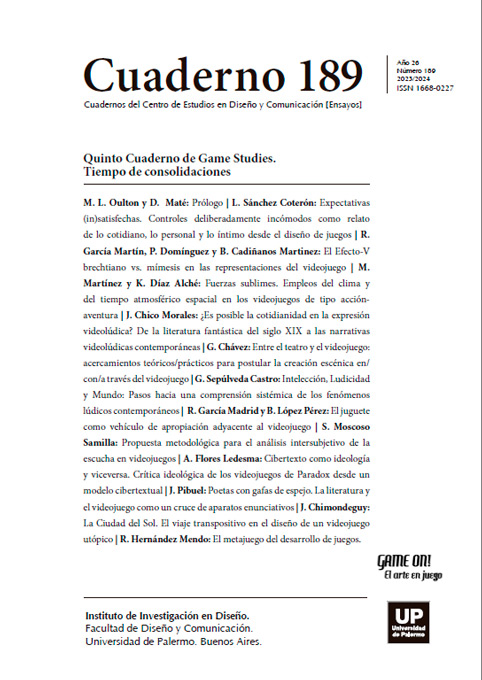Expectativas (in)satisfechas. Controles deliberadamente incómodos como relato de lo cotidiano, lo personal y lo íntimo desde el diseño de juegos
Keywords:
game design ; counter game feel ; awkward controls ; interactive biopics
Abstract
This paper explores the critical potentiality of deliberately awkward game controls, beyond the mostly humorous uses, when in conjunction with wacky physics.
References
Ahmed, S. (2006). Queer Phenomenology: Orientations, Objects, Others. Duke University
Press. Anable, A. (2018). Playing with Feelings: Video Games and Affect. University of Minnesota Press.
Barr, P. (2016). Critical Jostling. G|A|M|E Games as Art, Media, Entertainment, 1(5). https://www.gamejournal.it/?p=2898
DeJong, S. (Anfitrión), Lajeunesse, M. (Anfitrión), & Zanescu, A. (Anfitrión) (2021). How is Humor Structured? Humour and Games (2020). Technoculture, Art and Games (TAG)
Research Center. Concordia University, Montréal. (S1E3) [Episodio de Podcast]. En Humour and Games. Spotify https://open.spotify.com/episode/7Ev1R86odmRya8em0jvDVw?si=a084f32473114d6e
Dunne, A. (2005). Hertzian tales: Electronic products, Aesthetic Experience, and Critical Design. MIT Press.
Gray, K. (2020). Intersectional Tech: Black Users in Digital Gaming. Louisiana State University Press.
Green, B. (2 de junio de 2005). One Button Games. Game Developer. https://www.gamedeveloper.com/design/one-button-games
Grönroos, A.-M. (2013). Humour in Video Games. Play, Comedy, and Mischief. University School of Art, Design and Architecture. Aalto University.
Haraway, D. J. (1991). Simians, Cyborgs, and Women. The Reinvention of Nature. Routledge.
Isbister, K. (2016). How Games Move Us. Emotion by Design. MIT Press.
Salen, K., & Zimmerman, E. (2004). Rules of play: Game design fundamentals. Mit Press.
Shinkle, E. (2005). Feel It, Don’t Think: The Significance of Affect in the Study of Digital Games. Digital Games Research Association DiGRA. http://www.digra.org/wp-content/uploads/digital-library/06276.00216.pdf
Suits, B. H. (2005). The Grasshopper: Games, Life, and Utopia. Broadview Press.
Swink, S. (2008). Game Feel: A Game Designer’s Guide to Virtual Sensation. Routledge.
Press. Anable, A. (2018). Playing with Feelings: Video Games and Affect. University of Minnesota Press.
Barr, P. (2016). Critical Jostling. G|A|M|E Games as Art, Media, Entertainment, 1(5). https://www.gamejournal.it/?p=2898
DeJong, S. (Anfitrión), Lajeunesse, M. (Anfitrión), & Zanescu, A. (Anfitrión) (2021). How is Humor Structured? Humour and Games (2020). Technoculture, Art and Games (TAG)
Research Center. Concordia University, Montréal. (S1E3) [Episodio de Podcast]. En Humour and Games. Spotify https://open.spotify.com/episode/7Ev1R86odmRya8em0jvDVw?si=a084f32473114d6e
Dunne, A. (2005). Hertzian tales: Electronic products, Aesthetic Experience, and Critical Design. MIT Press.
Gray, K. (2020). Intersectional Tech: Black Users in Digital Gaming. Louisiana State University Press.
Green, B. (2 de junio de 2005). One Button Games. Game Developer. https://www.gamedeveloper.com/design/one-button-games
Grönroos, A.-M. (2013). Humour in Video Games. Play, Comedy, and Mischief. University School of Art, Design and Architecture. Aalto University.
Haraway, D. J. (1991). Simians, Cyborgs, and Women. The Reinvention of Nature. Routledge.
Isbister, K. (2016). How Games Move Us. Emotion by Design. MIT Press.
Salen, K., & Zimmerman, E. (2004). Rules of play: Game design fundamentals. Mit Press.
Shinkle, E. (2005). Feel It, Don’t Think: The Significance of Affect in the Study of Digital Games. Digital Games Research Association DiGRA. http://www.digra.org/wp-content/uploads/digital-library/06276.00216.pdf
Suits, B. H. (2005). The Grasshopper: Games, Life, and Utopia. Broadview Press.
Swink, S. (2008). Game Feel: A Game Designer’s Guide to Virtual Sensation. Routledge.
Published
2023-05-22
How to Cite
Sánchez Coterón, L. (2023). Expectativas (in)satisfechas. Controles deliberadamente incómodos como relato de lo cotidiano, lo personal y lo íntimo desde el diseño de juegos. Cuadernos Del Centro De Estudios De Diseño Y Comunicación, (189). https://doi.org/10.18682/cdc.vi189.9516
Section
Artículos
Los autores/as que publiquen en esta revista ceden los derechos de autor y de publicación a "Cuadernos del Centro de Estudios de Diseño y Comunicación", Aceptando el registro de su trabajo bajo una licencia de atribución de Creative Commons, que permite a terceros utilizar lo publicado siempre que de el crédito pertinente a los autores y a esta revista.


